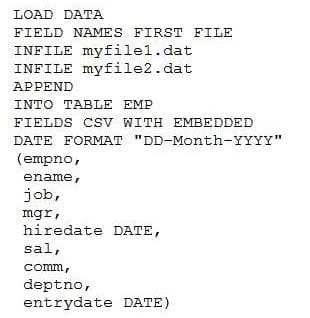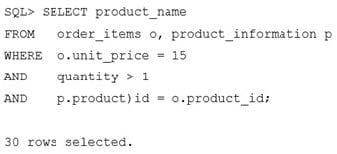Exam Details
Exam Code
:1Z0-060Exam Name
:Upgrade to Oracle Database 12cCertification
:Oracle CertificationsVendor
:OracleTotal Questions
:217 Q&AsLast Updated
:Jun 25, 2025
Oracle Oracle Certifications 1Z0-060 Questions & Answers
-
Question 151:
Examine the contents of SQL loader control file:

Which three statements are true regarding the SQL* Loader operation performed using the control file?
A. An EMP table is created if a table does not exist. Otherwise, if the EMP table is appended with the loaded data.
B. The SQL* Loader data file myfile1.dat has the column names for the EMP table.
C. The SQL* Loader operation fails because no record terminators are specified.
D. Field names should be the first line in the both the SQL* Loader data files.
E. The SQL* Loader operation assumes that the file must be a stream record format file with the normal carriage return string as the record terminator.
-
Question 152:
You execute a DROP USER CASCADE on an Oracle 11g release 1 database and immediately realized that you forgot to copy the OCA.EXAM_RESULTS table to the OCP schema.
RECYCLE_BIN was enabled before the DROP USER was executed and the OCP user has been granted the FLASHBACK ANY TABLE system privilege.
What is the quickest way to recover the contents of the OCA.EXAM_RESULTS table to the OCP schema?
A. Execute FLASHBACK TABLE OCA.EXAM_RESULTS TO BEFORE DROP RENAME TO OCP.EXAM_RESULTS; connected as SYSTEM.
B. Recover the table using traditional Tablespace Point In Time Recovery.
C. Recovery the table using Database Point In Time Recovery.
D. Execute FLASHBACK TABLE OCA.EXAM_RESULTS TO BEFORE DROP RENAME TO EXAM_RESULTS; connected as the OCP user.
-
Question 153:
In your multitenant container database (CDB) that contains pluggable databases (PDBs), the HR user executes the following commands to create and grant privileges on a procedure:

How can you prevent users having the EXECUTE privilege on the CREATE_TEST procedure from inserting values into tables on which they do not have any privileges?
A. Create the CREATE_TEST procedure with definer's rights.
B. Grant the EXECUTE privilege to users with GRANT OPTION on the CREATE_TEST procedure.
C. Create the CREATE_TEST procedure with invoker's rights.
D. Create the CREATE_TEST procedure as part of a package and grant users the EXECUTE privilege the package.
-
Question 154:
You created a new database using the "create database" statement without specifying the "ENABLE PLUGGABLE" clause.
What are two effects of not using the "ENABLE PLUGGABLE database" clause?
A. The database is created as a non-CDB and can never contain a PDB.
B. The database is treated as a PDB and must be plugged into an existing multitenant container database (CDB).
C. The database is created as a non-CDB and can never be plugged into a CDB.
D. The database is created as a non-CDB but can be plugged into an existing CDB.
E. The database is created as a non-CDB but will become a CDB whenever the first PDB is plugged in.
-
Question 155:
What is the effect of specifying the "ENABLE PLUGGABLE DATABASE" clause in a "CREATE DATABASE" statement?
A. It will create a multitenant container database (CDB) with only the root opened.
B. It will create a CDB with root opened and seed read only.
C. It will create a CDB with root and seed opened and one PDB mounted.
D. It will create a CDB that must be plugged into an existing CDB.
E. It will create a CDB with root opened and seed mounted.
-
Question 156:
You create a new pluggable database, HR_PDB, from the seed database.
Which three tablespaces are created by default in HR_PDB? (Choose three.)
A. SYSTEM
B. SYSAUX
C. EXAMPLE
D. UNDO
E. TEMP
F. USERS
-
Question 157:
Which two statements are true about variable extent size support for large ASM files?
A. The metadata used to track extents in SGA is reduced.
B. Rebalance operations are completed faster than with a fixed extent size
C. An ASM Instance automatically allocates an appropriate extent size.
D. Resync operations are completed faster when a disk comes online after being taken offline.
E. Performance improves in a stretch cluster configuration by reading from a local copy of an extent.
-
Question 158:
Examine the following query output:

You issue the following command to import tables into the hr schema:
$ > impdp hr/hr directory = dumpdir dumpfile = hr_new.dmp schemas=hr TRANSFORM=DISABLE_ARCHIVE_LOGGING: Y
Which statement is true?
A. All database operations performed by the impdp command are logged.
B. Only CREATE INDEX and CREATE TABLE statements generated by the import are logged.
C. Only CREATE TABLE and ALTER TABLE statements generated by the import are logged.
D. None of the operations against the master table used by Oracle Data Pump to coordinate its activities are logged.
-
Question 159:
You notice a performance change in your production Oracle database and you want to know which change has made this performance difference.
You generate the Compare Period Automatic Database Diagnostic Monitor (ADDM) report to further investigation.
Which three findings would you get from the report?
A. It detects any configuration change that caused a performance difference in both time periods.
B. It identifies any workload change that caused a performance difference in both time periods.
C. It detects the top wait events causing performance degradation.
D. It shows the resource usage for CPU, memory, and I/O in both time periods.
E. It shows the difference in the size of memory pools in both time periods.
F. It gives information about statistics collection in both time periods.
-
Question 160:
Examine the parameter for your database instance:

You generated the execution plan for the following query in the plan table and noticed that the nested loop join was done. After actual execution of the query, you notice that the hash join was done in the execution plan:

Identify the reason why the optimizer chose different execution plans.
A. The optimizer used a dynamic plan for the query.
B. The optimizer chose different plans because automatic dynamic sampling was enabled.
C. The optimizer used re-optimization cardinality feedback for the query.
D. The optimizer chose different plan because extended statistics were created for the columns used.
Related Exams:
1Z0-020
Oracle8i: New Features for Administrators1Z0-023
Architecture and Administration1Z0-024
Performance Tuning1Z0-025
Backup and Recovery1Z0-026
Network Administration1Z0-034
Upgrade Oracle9i/10g OCA to Oracle Database OCP1Z0-036
Managing Oracle9i on Linux1Z0-041
Oracle Database 10g: DBA Assessment1Z0-052
Oracle Database 11g: Administration Workshop I1Z0-053
Oracle Database 11g: Administration II
Tips on How to Prepare for the Exams
Nowadays, the certification exams become more and more important and required by more and more enterprises when applying for a job. But how to prepare for the exam effectively? How to prepare for the exam in a short time with less efforts? How to get a ideal result and how to find the most reliable resources? Here on Vcedump.com, you will find all the answers. Vcedump.com provide not only Oracle exam questions, answers and explanations but also complete assistance on your exam preparation and certification application. If you are confused on your 1Z0-060 exam preparations and Oracle certification application, do not hesitate to visit our Vcedump.com to find your solutions here.

